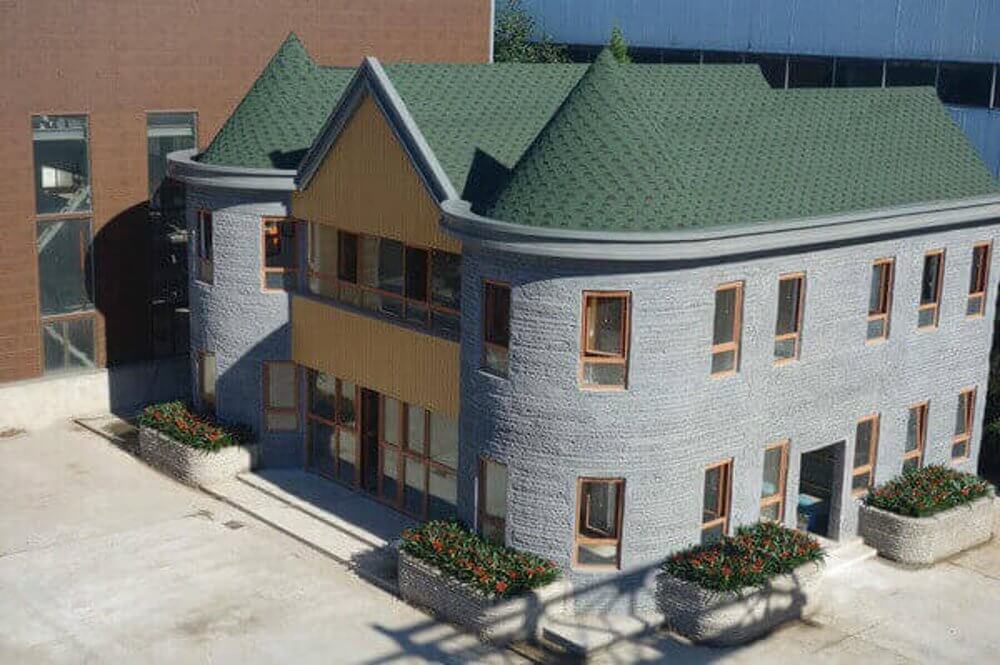Top 6 of the largest 3D printed objects! (2021 Update)
Posted By Kat Plewa on Dec 3, 2019 | 0 comments
From 3D printed hearts to car restorations, Additive Manufacturing has numerous applications in many industries, but did you know that it is also possible to 3D print on a large scale? Concrete houses, bridges or even ship propellers, 3D printing keeps bringing absolutely new, innovative solutions. What is the largest 3D printed object yet? Let’s find out!
#6 Titanium Brake Caliper by Bugatti
The automotive industry is certainly one that makes the most of 3D printing technologies. One of the leaders, Bugatti, wasn’t waiting for their competitors to start benefiting from Additive Manufacturing. They are creating a new path of production using the Selective Laser Sintering (SLS) technique.
Thanks to 3D printing, Bugatti made a huge improvement in their brake caliper design and manufacturing. The brake produced with traditional methods weighed 4.9 kg and was made out of aluminum. Additive Manufacturing allowed the engineers to use titanium, which is much stronger and robust. Not only that, but they could also use new design methods bringing the weight of caliper down to 2.9 kg!
Only 3D technologies could allow Bugatti’s team to reduce weight and at the same time improve the quality of the 3D printed part. Additive Manufacturing is the true future of the automotive industry.
#5 Two-level villa
Chinese company HuaShang Tengda knows how to produce impressive extra-large projects. Our Top 6 list of the largest 3D printed objects wouldn’t be complete without a concrete 3D printed habitat.
The revolution of using additive manufacturing for houses is the speed of producing them. HuaShang Tengda managed to build a two-story villa in just 45 days! They developed dedicated hardware but also developed an innovative technique complementing 3D printing. First, the frame of the building was put up and then a 3D printer laid the concrete.
To produce this XL object 20 tons of concrete were used! This 3D printed house shows another advantage of Additive Manufacturing: lowering material waste, which reflects on the costs. Most impressive is still the timeframe. 3D printing can improve your production by making it faster and therefore bringing the costs down.
#4 The largest 3D printed bridge
//www.sculpteo.com/blog/2019/02/20/meet-the-longest-3d-printed-bridge-in-the-world/
Another outstanding project on our list is the world’s longest 3D printed bridge produced in Shangai. The previous bridge was built during the Sui Dynasty (581- 618 CE) and it took 11 years to complete it.
To compare, the 3D printed structure was manufactured in less than 19 days! To make the bridge, 68 slide pieces and 64 deck pieces were 3D printed. What is so striking about this bridge is not only the manufacturing speed but also the fact that it includes senor accumulating displacement data which will be used later to improve the design of future 3D printed bridges.
On top of that, the bridge is very strong. It was tested during inauguration when 100 people stood on it at the same time! This experiment truly proves that Additive Manufacturing is totally capable of producing complex constructions that can withstand tons of stress.
#3 World’s first 3D printed propeller
Another industry where 3D printing is a groundbreaking solution to improving the production process is the maritime sector. One of the latest developments is WAAMpeller. It is the first-ever 3D printed ship propeller. Where its unique name comes from?
WAAM is a technology invented especially for this project. WAAM is short for Wire Arc Additive Manufacturing. This 3D method melts metal wire with an electric arc, layer by layer. The WAAMpeller is built of nickel aluminum bronze alloy and composed of 298 layers. The final result was truly impressive and fully functional! The 3D printed propeller was installed on a workboat Stan Tug 1606.
#2 3D printing and space exploration: Aeon 1
Can Additive Manufacturing improve space exploration? Yes! In fact, there are many different ways where 3D technologies print new, better solutions to space travel. Relativity Space, a young American start-up, saw the potential of 3D printing.
They developed robotic arms that are capable of 3D printing with metal. What for? To manufacture a rocket engine: Aeon 1! Rocket engines are extremely hard to design and produce, they are made of multiple parts which raises the risk of failure. Thanks to 3D techniques, the design od a rocket engine could be rethought.
Usually, this component of a rocket has many parts, but thanks to 3D printing, it was composed only of 3 parts! That’s a huge leap forward in terms of material usage, functionality, production time, and costs. It only took one month to manufacture Aeon 1, compared to 6 months when made with traditional technologies. Also, having fewer parts means a shortened assembly time.
Aeon 1 was successfully fired up on numerous occasions, which proves that it’s fully functional and ready for further improvements.
#1 Largest solid 3D printed object
The leader in aircraft manufacturing Boeing knows that producing aircraft is time-consuming and complicated. Not every tool needed to manufacture, for instance, wings, is available on the market. Special equipment is required for a plane to be built. This is exactly why 3D printing is the answer.
Thanks to 3D modeling, engineers from Oak Ridge National Laboratory (ORNL) in cooperation with Boeing were able to produce highly customized and at the same time, the largest ever solid 3D printed object. The part needed was a trim tool. The purpose of this tool is to hold Boeing 777x’s wing skin while it’s being machined and drilled. The tool holds the title of the largest 3D printed object in Guinness Records.
To be able to produce it, the researchers developed Big Area Additive Manufacturing (BAAM) 3D printer. The machine took only 30 hours, instead of 7 days, to produce a large-scale trim tool. The component is a combination of 80% ABS plastic and 20% carbon fiber. It weighs 745 kg, is 5.3 meters long, 1.5 meters wide and 0.5 meters tall. The 3D printed tool showcases how much potential lays in additive manufacturing for the aerospace industry.
What is the future of XL 3D printing?
As you see, there are some really impressive projects when it comes to the largest 3D printed object. From improving airplanes production, the longest bridges to building houses, Additive Manufacturing keeps on surprising us with its groundbreaking applications. And it definitely won’t stop there. Every year there are new solutions and projects that come up, such as the biggest yet 3D printed boat.
Big or small, if you have a 3D printing project, you can easily produce it with an online 3D printing service like Sculpteo. All you have to do is upload your file or contact us if you have any doubts.
Enjoyed this article? Don’t miss the next one! Subscribe to our Newsletter and follow us on Facebook now.


 Connect with Google
Connect with Google Connect with Facebook
Connect with Facebook
